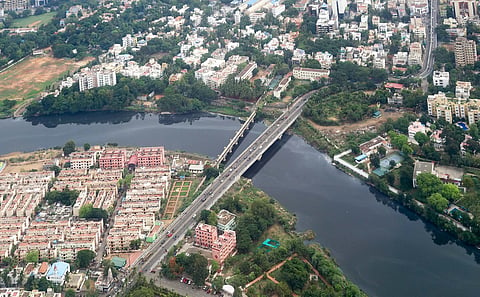

Five Indian megacities face an increasing threat of land subsidence, and the primary cause is excessive groundwater extraction, leading to structural risks for thousands of buildings and compounding threats from flooding and earthquakes.
A new study published in the journal Nature Sustainability on October 28, 2025, highlighted significant land subsidence in major Indian cities, affecting over 13 million buildings and nearly 80 million residents.
The analysis used satellite radar data from 2015-2023 to estimate differential settlements in five fast-growing Indian megacities — Delhi (National Capital Territory, NCT), Mumbai, Kolkata, Bengaluru and Chennai. This included more than 13 million buildings and 80 million people.
The analysis revealed 878 square kilometres of urban land subsiding, exposing 1.9 million people to subsidence rates of more than four millimetres per year.
Widespread subsidence was found in all cities, with maximum rates of 51.0 mm yr−1, 31.7 mm yr−1, 26.1 mm yr−1, 16.4 mm yr−1 and 6.7 mm yr−1 for Delhi, Chennai, Mumbai, Kolkata and Bengaluru, respectively.
The researchers also identified subsidence hotspots in most cities. Rates of up to 28.5 mm yr−1, 38.2 mm yr−1 and 20.7 mm yr−1 affected areas of Bijwasan, Faridabad and Ghaziabad in Delhi-NCR. In Chennai, the fastest subsidence rates surround the flood plains of the Adyar river and city centre areas, including Valasaravakkam, Kodambakkam, Alandur and Tondiarpet.
In Delhi, the primary driver of land subsidence is the compaction of alluvial deposits caused by extensive groundwater withdrawals.
In Chennai, the widespread subsidence observed in the city centre can be attributed to the compaction of alluvium deposits from Holocene fluvial sediments, especially in the floodplain of the Adyar river, characterised by sandy clay, silt and sand. In addition, the two major hotspots of subsidence in the city — K K Nagar and Tondiarpet — can be related to groundwater extraction, the study said.
The observed subsidence pattern in Kolkata could be attributed to the compaction of Pleistocene and Holocene sediments.
In Bengaluru, the widespread presence of igneous and metamorphic rocks such as gneiss, granodiorites and granite could be responsible for the relatively minimal subsidence witnessed. However, there was an increase in the extraction of groundwater in Bengaluru towards the end of 2022.
Subsidence is notably lower in the majority of Mumbai except in economically disadvantaged neighbourhoods for example, Dharavi with high-density informal settlements.
In addition to the potential compaction resulting from extensive groundwater extraction through millions of unregulated borewells, Indian megacities may also experience subsidence due to the cumulative weight of the urban structures above.
The study estimated that 2,264, 110 and 32 buildings in Delhi, Mumbai and Chennai are currently at high damage risk due to differential land subsidence.
The analysis suggests that in 30 years, an estimated 3,169, 958 and 255 buildings in Delhi, Chennai and Mumbai will face a very high risk of damage.
In 50 years, 11,457, 3,477, 112, 8,284 and 199 buildings in Delhi, Mumbai, Bengaluru, Chennai and Kolkata are expected to be at very high risk of damage. The results reveal that Chennai is characterised by a large number of buildings exposed to high and very high structural damage risk, surpassing Delhi and Mumbai in the far-future projections.
“Sustained over 50 years, current subsidence rates could place as many as 23,529 buildings at very high risk of structural damage in Chennai, Delhi, Mumbai, Kolkata and Bengaluru,” said the study led by Nitheshnirmal Sadhasivam, United Nations University, Canada.
The study also identified localised uplift in some cities, such as areas near Dwarka in Delhi that are rising at a rate of 15.1 mm yr−1.
The localised uplift in Dwarka is attributed to aquifer recharge, facilitated by government regulations implemented between the mid-2000s and 2011, which curtailed groundwater pumping, promoted rainwater harvesting and supported the revival of an old water body between 2012 and 2015, thereby mitigating strain on groundwater resources and enhancing recharge.
Land subsidence mitigation and adaptation strategies should be implemented, which include new regulations to reduce groundwater extraction, surface water management, groundwater recharge, re-vegetation and soil conservation.